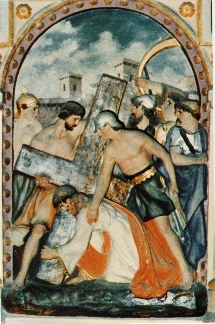
Elizabeth Van Buren has perhaps outshone anyone thus far in coming to terms with just how deep the mysterious symbolism of Rennes-le-Chateau runs, or just how far it reaches. Lionel and Patricia Fanthorpe often give gestures of approval and even indebtedness in their own work on Rennes-le-Chateau's mysteries.
If there is anything that can be said of any shortcomings of her work, it is perhaps that she has mastered the keys to the mysteries so well that it is difficult for anyone to follow her fully. I have not, for example, personally succeeded in subscribing wholeheartedly to her observations of a giant Zodiac surrounding Rennes-le-Chateau; alas I have a few remaining bouts with what so severely afflicts the cynics of Cydonia and other locations of ancient monuments on Mars (the dreaded and archaeologically naieve "it doesn't quite look like a ____ to me" complaint) and the supportive cultural connotations can be time-consuming and challenging to persue. Likewise, I am not always yet able to share some of her conclusions.
I have little doubt, however, that the vast majority of the contents of her "Refuge of the Apocalypse" are not only correct, but that they are downright ingenious observations, using an almost unparalleled broad mastery of symbolism of all sort. I have to take heed of her expertise and insights when she begins to disclose the deeper symbolism of the Stations of the Cross in Sauniere's church, and when she advises us of the correspondences of these scenes from the Crucifixion of Christ to the houses of the Zodiac.
While the animal symbols she often finds subtly woven into the folds of these scenes may seem dubious, it cannot be underscored enough that if these clues were to be any more apparent, they would not quite be the mystery they were intended to be, and in fact these scenes, which have long survived through their innocuous and religious air, might never have survived nearly so long were these symbols not so less-than-apparent.
While this may sound like an excuse, especially to that legion of persons who weild unbelievable cynicism at the Monuments of Mars, and strip the whole matter from any scientific or historical context to complain that they can see "faces" "anywhere"- (a perfectly appauling list of those places will not be included here), that is nonetheless the fact. Saniere's masterful creations might never have been expected to endure should a visiting luminary of the Church's hierarchy have visited and exclaimed, "What is that bear doing in the Crucifixion of Christ? It is sacrilege! Remove it at once!".
While those cynics who would reflexively try to "debunk" Van Buren's notions have in all likelihood never laid eyes on Rennes-le-Chateau, Van Buren has long been a resident of this small French village, and no doubt seen Sauniere's Stations of the Cross perhaps countless times, from perhaps every angle and in many different lights. In other words, she is, after all, an authority. As always, it is through the support of symbolism, and the precise symbolism, that is, through the specific cultural connotations, that we can find the support for such observations as Van Buren's.
There is some irony in the coincidental timing of "The Daily Grail" listing of a news item describing how computer imaging is aiding historians in recreating parts of ancient relics that were thought lost forever, for the ability to bring out data in images that may not be plain to the naked eye. Such techniques could closely resemble those used by detectives to acquire information and clues which would otherwise be thought destroyed, as well as those used in remote sensing archeology to recover information that is likewise not apparent through straightforward optical imaging.
I am using uncompressed jpegs here, to prevent further degradation of scans already made gritty by both the workings of the printing of the image I am using, and the workings of the scanner- objectional qualities worsened by such techniques as the histogram equalization that has been used in several instances, and the use of gamma and contrast adjustments, in order that the reader can better see what is already often much more apparent to my own eye (which I hope I may consider to be trained, being the veteran of anomaly hunting though thousands of space images, ferreting out subtle details that are often almost completely lost). Short of attempting the impossible, I have nothing against keeping the cynics in mind.
Please be patient, however, with the remaining images in this work to download, since they are of the nature of very large jpegs, even though they appear quite small; uncompressed, they use over ten times the data than they would if they had been compressed to save size.
I will forego here for brevity many of Elizabeth's remarkable discoveries and discussions of symbolism, and allow readers to seek out her enthralling and indispensible works for themselves.
Likewise, this is only intended to be a brief introduction to the implications of an evening of studying in the images what was spotted in previous observations of small unaltered images. As such, only three of fourteen Stations of the Cross are examined here. There is still much left to explore...

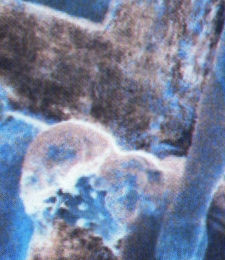
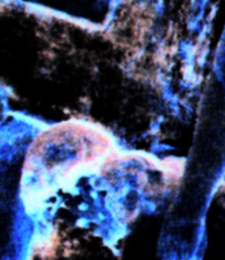
Two versions of a negative of a section of Christ's head and the upward-facing right arm of the cross (laying on it's left arm) above it. There seems to be a large, if faint, Cydonia-like face slightly sculpted into the center of the cross. The mouth may be more distinguishable in the lighter version at left, and the outline of the headdressed face hopefully somewhat more obvious at right. There seems to be a likely Cydonia face atop the head, a left-facing profile in the hair just above the forehead, and some curious shapes that suggest more extraterrestial icons in the lower falls of hair at the back of the head.
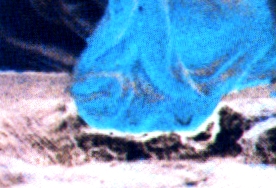
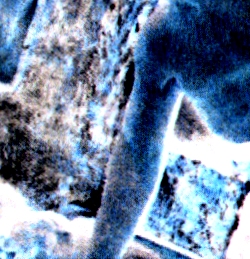 At left: Interestingly, although this is attributed to Gemini by Van Buren, the negative of the lowest falls of Christ's red cloak seem to contain a fairly convincing form of the astrological sign for Pisces. We will decline explanation for this at the moment, but this clip is included because there appears to be at least the left half of a Cydonia face's outlines appearing at an angle in front- to its left, slightly down- and apparently partly beneath it.
At left: Interestingly, although this is attributed to Gemini by Van Buren, the negative of the lowest falls of Christ's red cloak seem to contain a fairly convincing form of the astrological sign for Pisces. We will decline explanation for this at the moment, but this clip is included because there appears to be at least the left half of a Cydonia face's outlines appearing at an angle in front- to its left, slightly down- and apparently partly beneath it.
At right: More traces of the face in the center of the cross might be seen here, as well as another possible one that occurs far out on the arm of the cross reaching to the right.
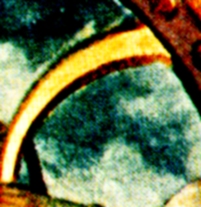
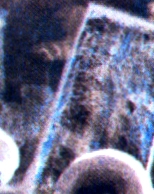
At left: Underneath the strange arc of the horn (almost more like a scimitar, which is relevant to the strange visual pun in which the horn participates, shown below, since it is another reiteration of the sword as symbol of ancestoral spacecraft, as seems to occur in many instaces, as the next upcoming Solar System Anomalies site will examine), there are very faint but noticible traces of another Cydonia face-form in the painted background. Note some of the misplaced-looking straight lines on either side of the horn.
At right: At least one Cydonia like face seems to appear in the upper part of the cross, molded subtly in faint relief, in this negative. Still hard to see, this face- or faces- may be one of the many things that more careful and elaborate computer imaging might make quite obvious. Another form we may be able to make out seems superimposed over the face just mentioned, it is looking left and seems almost identical to one of the first true Cydonia-like faces identified on earth, being a headdressed face at Chichen Itza which appeared in Brian Crowley and Anthony Pollock's remarkable "Return to Mars" (pg. 28). (Some closing remarks in relation to the "Mars-Moon-Mesoamerican Connection" will appear in the final page of this feature.)
Note that there is also quite a substantial Cydonia headdress form "peeking" out from behind the cross!

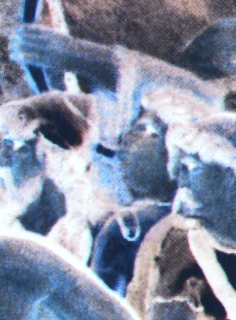 At right: Here is a remarkable visual pun... coming down over the shoulder of the leftmost face on the right side, is the foward part of a sort of ship, almost totally identical to those that can be found in countless examples of NASA space image data. The rear forks are formed by the sleeve and the horn in hand. The very tip of the front extention of the ship is formed by the danging strap on the horn, but it is absolutely remarkable how this scene responds to negation to aid the eye in seeing this feature. Our tell-tale clue seems to have been the odd unappealing, unartistic squaring of the arm reaching across the top of this clip.
At right: Here is a remarkable visual pun... coming down over the shoulder of the leftmost face on the right side, is the foward part of a sort of ship, almost totally identical to those that can be found in countless examples of NASA space image data. The rear forks are formed by the sleeve and the horn in hand. The very tip of the front extention of the ship is formed by the danging strap on the horn, but it is absolutely remarkable how this scene responds to negation to aid the eye in seeing this feature. Our tell-tale clue seems to have been the odd unappealing, unartistic squaring of the arm reaching across the top of this clip.
The fact that one rear fork shows as black, and the other white, is exactly what is to be expected from a bank of complex symbolism that has already been noted to illuminate everything from the principles by which such ancient spacecraft operated, to any implications of destinations outside the solar system (i.e., Sirius?) in which humans of this ancient solar system were able to reach in these fantastic vehicles. Here, both the Piscean fishes and Van Buren's suggested Gemini are relevant symbols; this pair of black and white forks are symbolically many things, from "Boaz and Jakin" to Janus and the Twins of Gemini. The horn, too, is subject to symbolic relevance here, albeit complex (the theme of the Resurrection Day, for example, may be evoked in the most esoteric sense possible, akin to the use of the concept, symbolically, by the Alchemists).
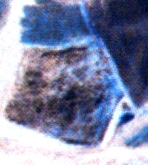 At left: three versions devoted to identifying two face like forms in the top arm of the crucifix which rests on its side to that this arm points toward the left. Two faces remain fairly consistent throught these variations, and those in the first frame have been mapped with color. The left facing profile that is colored may be superimposed on another forward-looking "Martian" face.
At left: three versions devoted to identifying two face like forms in the top arm of the crucifix which rests on its side to that this arm points toward the left. Two faces remain fairly consistent throught these variations, and those in the first frame have been mapped with color. The left facing profile that is colored may be superimposed on another forward-looking "Martian" face.
At right: The outline of a Cydonia face appearing within any pentagon, apparently commemorating Cydonia's pentagonal pyramid, especially one which is not alone in its immediate vicinity, is particularly compelling. This appears in the lowest part of the cross which is touching the ground, beneath Christ's left arm.

A second left-facing "fish" face might be contained in the depiction of rocks beneath the scene, but it's very curious to see at least one example of pentagonal geometry in the extreme lower left corner of the scene, as this negative reveals. Additional hints of faint Cydonia-like faces are colored in at right in this comparison version. Although apparently shown somewhat skewed, the upward-ponting pentagon, which appears light in this negative clip, may prove to have "the" geometry of Cydonia's D&M Pyramid, although apparently deliberate, artificial Martian pentagons may have been found to possibly vary considerably.
Note also the possible pentagon at farthest right actually pointing to the largest of these faces so much that it is overlapping it...
As odd as these might seem as candidates for a terrestial connection to Mars, or as unlikely, let's not forget that thanks to NASA's unexplainable negligence, it's a lot easier to go to France to confirm these if necessary than it is to go to Mars, and it's a lot cheaper to take pictures with your average camera than with Mars Global Surveyor. Additionally, there is no shortage of this data, and it isn't subject to the strange handling of many NASA images. In other words, it's relative very simple to get to the bottom of these faces!
But there is more...
Return to Solar System Anomalies III Index